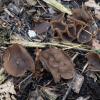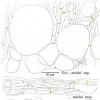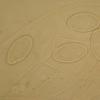
20-05-2014 13:23
Lepista ZacariasDear all,I need your help to try to identify what

19-05-2014 09:01
Dragiša SavicHi everyone. This Pleospora species I found on the

18-05-2014 22:25
Lepista ZacariasJe serai très reconnaissant si quelqu'un d'entre

07-05-2014 22:00
 Bernard Declercq
Bernard Declercq
Good evening, Collected on bark of Salix cinerea:

17-05-2014 22:42
 Hans-Otto Baral
Hans-Otto Baral
Hellohere is a pyrenomycete collected by Branislav
 Mon ami Bernd Fellmann demande de l'aide à déterminer :
Mon ami Bernd Fellmann demande de l'aide à déterminer :Les données de la trouvaille: ca 1300 m, dans la région de bord d'un chemin sur gravier calcaire / limoneux sous-sol avec alluviale sol / feuillage
Description:
Apothécies 1-4 pouces seul trophée en forme puis se propagent, traquées jusqu'à indiqué pétiole ( 5mm ) .
Hymenium foncé marron , brillant .
Gris-brun extérieur , seulement au sommet de la gamme avec des écailles brunes grandes .
Viande mince ( épaisseur de 1 à 2 mm , brun, effluent liquide incolore ( raison: le temps) ? .
Apothécie : spores sont fortement rejetées - mûre ! .
Les spores ; cylindrique , ellipsoïdale , 20-24 x 10-13 finement ciselé - verruqueux ( début de la formation d'une ornementation des spores ? )
sans guttules , avec desquamation de la coquille de mucus , noyau visible .
Paraphyses avec grand guttules de couleur jaune d'or dans la apicale , à court cloisonnées ( 30 - 40 ? ) , pointe étendues à 7 ? .
Asques 350-375 x 18-20 , IKI + , pleurorhynch .
Medulla au centre de textura intricata , excipulum textura globulosa / angularis cloisonnées par 1-3 fois , des excroissances ressemblant à des cheveux à 100 ? .
S'il vous plaît excuser la traduction de Google
Cordialement et merci d'avance, Karl
2014-05-15
Bernd complétée par des photos de la décharge de spores:
1.0 = spores dans H ² O
1.1 à 1.2 = spores en coton bleu
1.3 à 1.4 = spores dans le bleu de coton chauffée

Je joins notre article.

pour la réponse et pour votre description de Peziza dissingii.
Bernd a ajouté 5 photos pour voir les spores dans l'eau, en coton bleu et en coton bleu chauffée.
Amitiés, Karl (au nom de Bernd)
Chers Collègues,
Je ne pense pas qu'il s'agisse d'une véritable ornementation sporale !
Je propose que vous compariez votre espèce avec P. megalochondra (Le Gal) Donadini. Pour cela, je joins mes dessins et une photo de cette espèce. Les caractères spécifiques de cette espèce sont : le pigment jaune dans les paraphyses, dans les ascospores ( vers les pôles et visible à assez faible grossissement), le pigment jaune aux cloisons des cellules de la chair, ainsi que la taille très grande des cellules de l’exc. méd. supérieur, jusqu’à 200 µm et plus de diamètre.
Je n’ai pas d’autre idée pour cette espèce.
Amicalement
René
(pour des raisons de poids, les documents sont joins dans plusieurs dossiers réponses)
René

Dans l'annexe 2 autres photos.
zzz 1 "ornement"
zzz plus grande cellule dans la section
Je l'ai comparé avec P. megalochondra,
Je ne pense pas que le P. megalochondra est.
Les cellules les plus importants sont tous inférieurs à 100 µ.
Sur chaque spore il ya une ligne très fine comme "ornement" est parfois associée réticulaire.
Il est malheureusement très difficile pour moi de montrer sur un écran.
J'ai le champignon comparé avec les découvertes de P. dissingii de cette année; les spores sont légèrement plus mince et l'ornement typique est manquant. Sinon, tout serait s'adapter.
Est-il possible que l'ornement "normale" est formé par les circonstances météorologiques aucun?
Merci et cordialement,
Karl (au nom de Bernd)
P.S.: après Grangeneuve Karl apporte une exsiccat!
It looks really similar to my recent collection here:
http://www.ascofrance.com/search_forum/28529
I saw that old spores eventually became wrinkled, but only after germination (I think you can see where the conidiophores were attached in the photo)
It would be good to know if you saw conidiophores like the ones in my collection:)
Best regards,
Nick

I (Bernd Fellmann) had no germinating conidia spores in my Peziza.
Well, the striated spores look almost the same as mine.
But if I then go out of smooth spores then I come with Hohmeyer key to:
38a) Hymenium violet-blackish. Fruiting bodies 3-5 mm, sessile, lenticular, outside grobkleiig. Spores 19-22 (-23) x 10-12 microns. --- Boud.275:
Peziza recedens
38b) Hymenium sepia brown, gray brown, black and brown. Fruiting bodies up to 2 cm, sessile or short-stalked. Sometimes paraphyses above with dark brown droplets. Spores 18-22 x 11-13 microns. --- Denn.VII F; Cke.261:
Peziza sepiatra
Size of the fruiting body and the content of the paraphyses does not agree.
Comparison with Peziza granulosa: the spore size is right about, but the form does not agree (no conidia or wrinkling of the spores). Even comparing with my discovery of P.granulosa was not a golden yellow colored contents of the paraphyses.
I do not think my Peziza is P. granulosa.
Kind regards, Karl (in the name of Bernd)

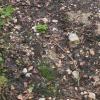
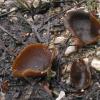
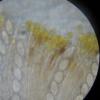
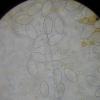
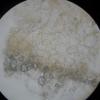
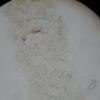

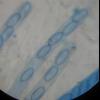
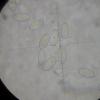

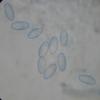
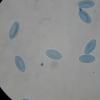
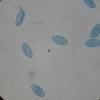
 Publication de Peziza dissingii
Publication de Peziza dissingii